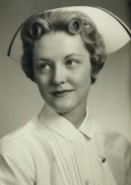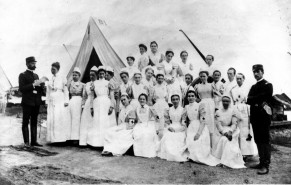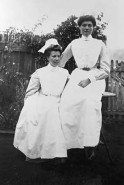 Ah, the portrait of a nurse.
Ah, the portrait of a nurse.
The freshly starched dress, that sharp little hat (oh, that hat!), the coveted pin; remnants of an era long forgotten.
Or are they? Just a few decades back, nurses were required to wear this cap. They had no choice but to button up that pinafore apron every day. And for what? Certainly not for sterilization, though that may have been the intent back then. Now we know better.
Join us as we remember the uniforms of decades past — and smile, because we’ll never force you to wear these outfits again. Ever. Unless you want to, of course.
To the left is an 1856 lithograph of the hospital ward at Scutari where Florence Nightingale worked (via Wikipedia).
In 1854, Florence Nightingale served during the Crimean War (one of the bloodiest wars in history), along with a staff of 38 volunteer nurses.
It was not until after the war that she discovered and advocated that sanitary living conditions were of great importance. There was not yet a nursing uniform, but instead a full-length dress similar to that of a nun.
The nursing uniforms of the late 1800s were modeled after a nun’s habit (as pictured on the left). They were worn in order to properly identify nurses, and to provide a full-length, “fever-proof” shield to protect the visiting nurse from infection. You’ll notice, however, that although the gown covers most of the body, the nurse is not wearing gloves or a mask.
Although Florence Nightingale’s work served as an inspiration for nurses in the American Civil War, her teachings on sanitation were not convincing to her colleagues at the time.
Nurses continued to wear the long “fever-proof” gowns, with hats that served little purpose beyond identification. No gloves or masks were worn.
Pictured on the right is Lillian Wald, a nurse, social worker, and public health official in the late 1800s to early 1900s.
First nurses at Sternberg Hospital, Chickamauga Park, Georgia, August 1898. Again, no masks or gloves, but the same full-length gown and apron to protect against infection, plus a new form of identification: the arm cuff with a large red cross.
In 1908, the Navy Nurse Corps was formed. Below is a photo of the first 20 Navy nurses to ever serve the United States.
As we can see on the left, the British nursing uniforms of the early 1900s were very, very similar to the ones seen in America at the time.
If we take a look around the world at this time, almost all nursing uniforms were the same: the long gown to protect from infection, the apron for the same reason, and some type of hat or armband to identify oneself as a nurse.
Finnish nurses in 1918 (below) had a similar uniform, but favored the more nun-like, long head covering.
























